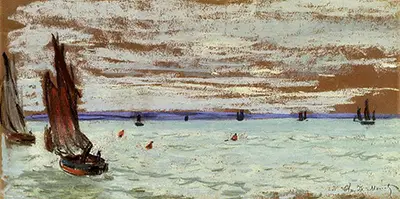Monet reverberates the canvas in tremendous confidence and joie-de-vivre way suggesting a powerful horizontal immersion with red-clad figures among the throng.
Monet witfully exploits the blue colour of the canvas evoking a moisture-laden albeit azure-tinted coastal light, forging a fascinating tour to the relationship between the impressionist master and the sea.
Offering substantial insight into the revolutionary development of his impressionist oeuvre, At Sea Pastel by Claude Monet is an extraordinary piece of the heralded legendary artist.
Monet's subtle entrancing works throughout his career reveal his lifelong fascination with light and atmosphere in illuminating a breath-taking ambience. At Sea Pastel by Claude Monet is no exception, with its exquisite light and avid immersion, the stunning pastel envisages Monet’s revolutionary impressionist style transcending naturalism in colour and form alike.
Among his first works en plein air that he composed in Normandy, At Sea Pastel by Claude Monet served as a significant precursor to the impressionistic and spontaneity verve of Monet’s oil paintings later on. His early painting from this epoch reveal undoubtedly the influences of great French landscape painters particularly those he encountered in his early days during their stay in Le Harve such as Eugene Boudin.
Who encouraged the young artist to set up his easel in the outdoors in order to astoundingly capture the vast, beautiful world around him, with Monet’s early style eventually vivaciously emulating the vibrant and natural light of his teacher.
As one of the venerated and recognized artists of all time, Claude Monet was a dedicated student of nature, budding with fascination about the tumultuous sea, ever-changing weather, and the subtle ephemeral quality of light. Related artists include Whistler, Renoir, Degas and Cezanne.
Monet held a profound enthrallment to perspective, the play of movement, and natural light in the composition of landscapes peerless in splendour. His ingenious recreative natural ephemeral phenomena on canvas is evident even in his crucial early pastel days standing as a significant precursor to his later paintings to come, but all maintaining his naturalist style.
Born in 1840 in Paris, Claude Monet is one of the most applauded leaders and pillar of the French revolutionary impressionist painting style, best known for his shimmering works in oil paints, as well as, transfixing pastels and drawings.
The intricate relationship between Monet and the sea, started soon as the young outgoing artist in the mid-1850’s along with his family were established in the coastal town of Le Havre. In these early fleeting years Monet did not feel the subtle appeal for the ‘Plein air’ painting, instead, he focused on creating caricatures of acquaintances and neighbours.
It was not long before the young artist caught the eye of Eugene Boudin – one of the greatest seascape painters if the 19th century – who had established himself years earlier at Le Havre.
In the duration of a few months, the master swayed the witting young artist to accompany him on one of his outdoors painting outings. It was from the tenacity of Eugene Boudin that Monet embraced his skill and grow to be a revolutionary painter transcending the canvas.


